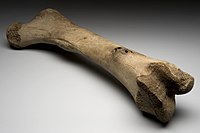
Photo from wikipedia
Hand bone morphology is regularly used to link particular hominin species with behaviors relevant to cognitive/technological progress. Debates about the functional significance of differing hominin hand bone morphologies tend to… Click to show full abstract
Hand bone morphology is regularly used to link particular hominin species with behaviors relevant to cognitive/technological progress. Debates about the functional significance of differing hominin hand bone morphologies tend to rely on establishing phylogenetic relationships and/or inferring behavior from epigenetic variation arising from mechanical loading and adaptive bone modeling. Most research focuses on variation in cortical bone structure, but additional information about hand function may be provided through the analysis of internal trabecular structure. While primate hand bone trabecular structure is known to vary in ways that are consistent with expected joint loading differences during manipulation and locomotion, no study exists that has documented this variation across the numerous bones of the hand. We quantify the trabecular structure in 22 bones of the human hand (early/extant modern Homo sapiens) and compare structural variation between two groups associated with post-agricultural/industrial (post-Neolithic) and foraging/hunter-gatherer (forager) subsistence strategies. We (1) establish trabecular bone volume fraction (BV/TV), modulus (E), degree of anisotropy (DA), mean trabecular thickness (Tb.Th) and spacing (Tb.Sp); (2) visualize the average distribution of site-specific BV/TV for each bone; and (3) examine if the variation in trabecular structure is consistent with expected joint loading differences among the regions of the hand and between the groups. Results indicate similar distributions of trabecular bone in both groups, with those of the forager sample presenting higher BV/TV, E, and lower DA, suggesting greater and more variable loading during manipulation. We find indications of higher loading along the ulnar side of the forager sample hand, with high site-specific BV/TV distributions among the carpals that are suggestive of high loading while the wrist moves through the 'dart-thrower's' motion. These results support the use of trabecular structure to infer behavior and have direct implications for refining our understanding of human hand evolution and fossil hominin hand use.
Journal Title: Journal of human evolution
Year Published: 2018
Link to full text (if available)
Share on Social Media: Sign Up to like & get
recommendations!